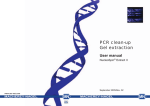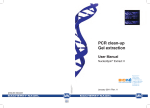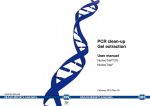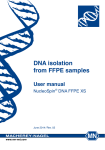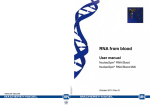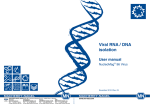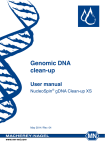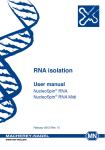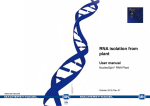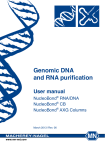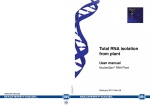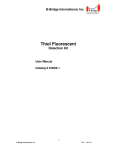Download PCR clean-up Gel extraction
Transcript
PCR clean-up Gel extraction User manual A019950 R01en2/10/0/01.12 PD Printed in Germany NucleoSpin® Gel and PCR Clean-up www.mn-net.com MACHEREY-NAGEL January 2012 / Rev. 02 MACHEREY-NAGEL MACHEREY-NAGEL MN EN ISO 9001: 2008 CERTIFIED PCR clean-up, gel extraction Protocol-at-a-glance (Rev. 02) 1 PCR clean-up Gel extraction DNA clean-up (with SDS) Single stranded DNA clean-up 200 μL NTI/ 100 μL PCR 200 μL NTI/ 100 mg gel 500 μL NTB/ 100 μL sample 200 μL NTC/ 100 μL sample PCR clean-up, DNA clean-up, or single stranded DNA clean-up: Adjust binding condition Gel extraction: Excise DNA fragment / solubilize gel slice 50 °C 5–10 min 2 Bind DNA 11,000 x g 30 s 3 Wash silica membrane 700 μL NT3 11,000 x g 30 s Recommended: 2nd wash 700 μL NT3 11,000 x g 30 s 4 Dry silica membrane 11,000 x g 1 min 5 Elute DNA 15–30 μL NE RT 1 min 11,000 x g 1 min MACHEREY-NAGEL GmbH & Co. KG · Neumann-Neander-Str. 6–8 · 52355 Düren · Germany Tel.: +49 24 21 969-270 · Fax: +49 24 21 969-199 · [email protected] · www.mn-net.com PCR clean-up, gel extraction Table of contents 1 Components 4 1.1 Kit contents 4 1.2 Reagents, consumables, and equipment to be supplied by user 5 1.3 About this user manual 5 2 Product description 6 2.1 The basic principle 6 2.2 Kit specifications 6 2.3 Removal of small DNA fragments and primer-dimers 8 2.4 pH indicator 9 2.5 Tips and tricks for extractions from agarose gels 10 2.6 DNA recovery depends on fragment size and elution volume 11 2.7 Salt carry-over and low A260 / A230 13 3 Storage conditions and preparation of working solutions 15 4 Safety instructions 16 4.1 Risk and safety phrases 16 4.2 GHS classification 17 5 Protocols 18 5.1 PCR clean-up 18 5.2 DNA extraction from agarose gels 20 5.3 DNA extraction from polyacrylamide gels 22 5.4 RNA extraction from agarose gels (Buffer NTC) 24 5.5 DNA clean-up of samples containing SDS (Buffer NTB) 25 5.6 Single stranded DNA clean-up (Buffer NTC) 26 6 Appendix 27 6.1 Troubleshooting 27 6.2 Ordering information 30 6.3 References 30 6.4 Product use restriction / warranty 31 MACHEREY-NAGEL – 01 / 2012, Rev. 02 3 PCR clean-up, gel extraction 1Components 1.1 Kit contents NucleoSpin® Gel and PCR Clean-up 10 preps 50 preps 250 preps 740609.10 740609.50 740609.250 Binding Buffer NTI 10 mL 2 x 25 mL 2 x 120 mL Wash Buffer NT3 (Concentrate)* 6 mL 20 mL 2 x 50 mL Elution Buffer NE** 5 mL 15 mL 50 mL NucleoSpin® Gel and PCR Clean-up Columns (yellow rings) 10 50 250 Collection Tubes (2 mL) 10 50 250 User manual 1 1 1 REF * For preparation of working solutions and storage conditions see section 3. **Composition of Elution Buffer NE: 5 mM Tris/HCl, pH 8.5 4 MACHEREY-NAGEL – 01 / 2012, Rev. 02 PCR clean-up, gel extraction 1.2 Reagents, consumables, and equipment to be supplied by user Reagents • 96–100 % ethanol Consumables • • 1.5 mL microcentrifuge tubes Disposable pipette tips Equipment • Manual pipettors • Heating block, water bath, or thermomixer for gel extraction • • • • Centrifuge for microcentrifuge tubes Scalpel to cut agarose gels Vortex mixer Personal protection equipment (lab coat, gloves, goggles) 1.3 About this user manual It is strongly recommended reading the detailed protocol sections of this user manual if the NucleoSpin® Gel and PCR Clean-up kit is used for the first time. Experienced users, however, may refer to the Protocol-at-a-glance instead. The Protocol-at-aglance is designed to be used only as a supplemental tool for quick referencing while performing the purification procedure. All technical literature is available on the internet at www.mn-net.com. Please contact Technical Service regarding information about changes of the current user manual compared to previous revisions. MACHEREY-NAGEL – 01 / 2012, Rev. 02 5 PCR clean-up, gel extraction 2 Product description 2.1 The basic principle NucleoSpin® Gel and PCR Clean-up is developed as a 2-in-1 kit allowing DNA fragments to be purified from enzymatic reactions, such as PCR, as well as from agarose gels. The sample is mixed with Binding Buffer NTI and in case of a cut-out gel band, it is heated to dissolve the agarose. In the presence of chaotropic salt, the DNA is bound to the silica membrane of a NucleoSpin® Gel and PCR Clean-up Column. Contaminations are removed by simple washing steps with ethanolic Wash Buffer NT3. Finally, the pure DNA is eluted under low salt conditions with slightly alkaline Elution Buffer NE (5 mM Tris/HCl, pH 8.5). 2.2 Kit specifications • NucleoSpin® Gel and PCR Clean-up is designed for fast purification of PCR products, such as DNA from enzymatic reactions, as well as the extraction of DNA fragments from TAE or TBE agarose gels. • Only two volumes of binding buffer per volume of sample are needed to process up to 200 μL of PCR / enzymatic reaction, or 200 mg of agarose gel, with only one loading step. By adding additional Binding Buffer NTI (see ordering information) it is possible to load an unlimited amount of sample volumes onto a single column (tips and tricks in section 2.5). • Up to ~ 15 μg DNA from 50 bp to at least ~ 20 kbp can be purified efficiently in 10–20 min with average recoveries from ~ 60 to ~ 90 % depending on the fragment size and elution procedure (details in section 2.6). • The NucleoSpin® Gel and PCR Clean-up buffer formulation ensures complete removal of all kinds of contaminations such as - nucleotides, primers - enzymes - mineral oil - PCR additives (e.g., salts, betaine, DMSO) - detergents (e.g., Tween 20, Triton X-100) - dyes (e.g., ethidiumbromide, crystal violet, Stain G, Midori Green, Roti®-Safe GelStain) - unbound labels and tags • 6 Primers from PCR reactions are quantitatively eliminated while small DNA fragments are still bound and purified with high recovery (details in section 2.6). MACHEREY-NAGEL – 01 / 2012, Rev. 02 PCR clean-up, gel extraction • The cut-off for small DNA fragments can be shifted from < 50 bp to several hundred bp by diluting Binding Buffer NTI to remove primer-dimers from target PCR products (details in section 2.3). • The pH-indicator in Binding Buffer NTI ensures optimal binding conditions with pH < 7.0 (details in section 2.4). The yellow color makes it easier to identify undissolved agarose during DNA gel extraction. • NucleoSpin® Gel and PCR Clean-up can be used with all kinds of agarose gels (high or low melting) with 1 % to 5 % agarose and a variety of buffer systems like TAE or TBE (tips and tricks in section 2.5). The kit also works with low conductivity borate electrophoresis systems. • Concentrated elution in down to 10 μL Elution Buffer NE (details in section 2.6). • Several support protocols extend the application range of NucleoSpin® Gel and PCR Clean-up to - Clean-up of DNA from reaction mixtures containing SDS (section 5.5) - Extraction of RNA from agarose gels (section 5.4) • - Clean-up of single stranded DNA (section 5.6) - Extraction of DNA from polyacrylamide gels (section 5.3) The purified and concentrated DNA can directly be used for hybridization, sequencing, PCR, restriction, ligation, in vitro transcription, labeling or any other kind of enzymatic reaction. Table 1: Kit specifications at a glance NucleoSpin® Gel and PCR Clean-up Parameter Sample material Up to 200 μL of PCR reaction or 200 mg of gel (more sample with additional Binding Buffer NTI and multiple loading steps) Binding capacity 25 μg Fragment length 50 bp – ~ 20 kbp Elution volume 10–30 μL Optimal recovery < 15 μg, 100–500 bp, 30 μL Preparation time 10 min for 6 PCR purifications 20 min for 6 gel extractions MACHEREY-NAGEL – 01 / 2012, Rev. 02 7 PCR clean-up, gel extraction 2.3 Removal of small DNA fragments and primer-dimers NucleoSpin® Gel and PCR Clean-up is designed to remove even traces of unused primer while purifying PCR products down to 50 bp at the same time. However, in some cases it is necessary to exclude these small fragments. For example, primer dimers, or side products resulting from unspecific annealing, may interfere with downstream sequencing or cloning applications. Removal of double stranded DNA > 50 bp can be achieved by diluting an aliquot of Buffer NTI with sterile water in an appropriate ratio and then proceeding with the standard protocol (see section 5.1). Diluting Buffer NTI in a certain range lowers the binding efficiency for small fragments without compromising the recovery of larger PCR products. However, the dilution ratio will highly depend on the fragment. Therefore, for each size of small fragments > 50 bp that has to be removed, as well as for each PCR system, the appropriate ratio of Buffer NTI dilution can be determined in advance. Influence of fragment size: The smaller the fragment in question, the less you have to dilute Buffer NTI. Influence of PCR buffer system: The influence of the PCR buffer system on the removal of small fragments is more complex. Some reaction buffers contain detergents like Tween or high concentrations of additives like betaine to lower the melting temperature of the DNA template. These substances can usually be found in PCR buffers for high fidelity or long range PCR. They tend to lower the binding efficiency of DNA to the silica membrane and therefore have to be considered when choosing a dilution ratio of Buffer NTI. As a rule of thumb, if a PCR buffer system without special additives is used, adding 3 to 5 volumes of water to 1 volume of Buffer NTI will lead to removal of small fragments up to 100 bp. Otherwise adding 1 to 3 volumes of water to 1 volume of Buffer NTI will be sufficient. Therefore, for each size of small fragments > 50 bp that has to be removed, and for each PCR system, you can determine the appropriate ratio of Buffer NTI dilution, in advance. Figure 1 shows a purification result with a Buffer NTI dilution series. Pure Buffer NTI (lane 3), as well as Buffer NTI plus one volume of water (lane 4), lead to 100 % recovery of a PCR fragment ladder (lane 2). More diluted Buffer NTI cuts off more and more of the low molecular mass bands. Usually a dilution with 5 volumes of water should be sufficient to eliminate even larger unwanted primer-dimer fragments while purifying the 164 bp fragment with > 90 %. 8 MACHEREY-NAGEL – 01 / 2012, Rev. 02 PCR clean-up, gel extraction 1 2 3 4 5 6 7 8 9 10 11 12 [bp/nt] - 982 - 645 - 359 - 164 - 100 - 79 - 65 50 - 21 Vol NTI – Vol water – % NTI – 1 1 0 1 100 50 1 2 33 1 3 25 1 4 20 1 5 17 1 6 14 1 7 13 1 8 11 1 9 10 Figure 1: Purification of PCR reactions using Buffer NTI dilutions Lane 1: GeneRuler 100 bp DNA Ladder (MBI Fermentas) Lane 2: DNA ladder input (21 base primer, 50, 65, 79, 100, 164, 359, 645 and 982 bp fragment) amplified using Biotaq DNA Polymerase (Bioline) Lane 3: Purification with 100 % Buffer NTI Lane 4 - 12: Purification with Buffer NTI diluted with 1–9 volumes of water 2.4 pH indicator The optimal pH to bind even small DNA fragments to the silica membrane of the NucleoSpin® Gel and PCR Clean-up Columns is approximately 5.0–6.0. The Binding Buffer NTI is sufficiently buffered to maintain this pH for all standard PCR reaction buffers or agarose gel buffer systems. In addition, the colored binding buffer helps identify undissolved pieces of agarose during DNA gel extraction. 12 11 10 blue green pH 9 8 7 6 yellow 5 4 Figure 2: Titration curve of Binding Buffer NTI with pH indicator MACHEREY-NAGEL – 01 / 2012, Rev. 02 9 PCR clean-up, gel extraction A yellow color indicates the optimal pH < 6.0 (Figure 2). If the pH increases to around 7 after adding the sample, the solution will turn green. In addition, an even higher pH will be signaled by a blue color. If a change in color is observed, the pH should be corrected by adding more Buffer NTI or by titrating the pH back to < 6.0 with 4 M sodium acetate pH 5.0 or small amounts of hydrochloric acid (HCl). 2.5 Tips and tricks for extractions from agarose gels Subject Recommendation Buffer system TBE (Tris-Borate-EDTA) buffer has a higher buffering capacity than TAE (Tris-Acetate-EDTA) which is needed for runs overnight and offers a better resolution for small DNA fragments. TBE buffer can be used in combination with NucleoSpin® Gel and PCR Clean-up. However, it is preferred to use fresh TAE buffer over TBE for preparative agarose gels. TAE does not interact with agarose, resulting in higher DNA yields. Additionally, linear DNA runs faster and the resolution of large DNA fragments is higher. Furthermore, supercoiled plasmid is separated better from linear and open circle DNA. Running conditions The temperature during electrophoresis should be low in order to increase the resolution of the DNA separation and avoid melting of the gel, thus causing denaturation of the DNA. Use fresh buffer and run the gel at low voltage (< 60 V), for as short as possible. As soon as the DNA band of interest is sufficiently separated from the rest, stop the gel and cut out the band. Cutting out the band Expose the gel to UV light as short as possible. Use the longest UV wave length that is allowed by your gel documentation system. Prolonged exposure and short wave lengths can damage the DNA. Wear gloves and a face mask to protect your skin and eyes from UV light. Make sure to cut through the gel vertically and remove all excess agarose. Use 0.7–1.0 % agarose gels rather than higher percentages. Size of gel piece Make sure to actually weigh the gel since its weight is easily underestimated. Up to 200 mg of agarose gel can be dissolved with 400 μL of Buffer NTI and loaded onto the column in one step. However, virtually unlimited amounts of gel can be loaded without clogging the column by increasing Buffer NTI proportionally (see ordering information) and adding multiple loading steps. 10 MACHEREY-NAGEL – 01 / 2012, Rev. 02 PCR clean-up, gel extraction 2.6 DNA recovery depends on fragment size and elution volume Upon completion of the wash steps with Buffer NT3, the DNA will adhere to the silica membrane. The number of interactions with Si-OH groups of the silica increase with the size of the DNA fragment. As a result, large DNA with several kilo base pairs binds much stronger and is much more difficult to elute than small DNA with just several hundred base pairs. NucleoSpin® Gel and PCR Clean-up is recommended for DNA up 10–15 kbp. Longer fragments can be purified but recovery may be low. In addition, fragments larger than 20 kbp may be mechanically damaged by the fast centrifugation through the membrane. For very large fragments, consider using NucleoTrap® or NucleoTraP®CR (see ordering information). To elute the DNA, water with a pH > 7 is needed to reestablish the hydrate shell. It is highly recommended to elute DNA with Elution Buffer NE (5 mM Tris/HCl, pH 8.5) which is provided with the kit. However, a standard TE buffer may also be used to ensure best elution efficiency. Please note that EDTA in TE buffer may cause problems in subsequent enzymatic reactions. Do not use deionized water since its pH is usually too acidic. If even less salt than the 5 mM Tris has to be used, dilute Elution Buffer NE with distilled water and make sure the pH is still > 7. Unbuffered elution buffer should not be used. The standard elution buffer volume is 15–30 μL which is the best compromise for high DNA recovery and high DNA concentration for fragments < 1000 bp (Figure 3). DNA recovery 100 % 80 % 60 % PCR Gel 40 % 20 % 0% 50 bp 100 bp 250 bp 500 bp 750 bp 1 kbp 3 kbp 5 kbp Fragment length Figure 3: Fragment length dependent DNA recovery 2 μg of 100 bp DNA ladder (Fermentas) or 2 μg of linearized vectors of 3 and 5 kbp were purified from standard PCR buffer or 200 mg 1 % TAE agarose gel. DNA was eluted in 30 μL Elution Buffer NE. MACHEREY-NAGEL – 01 / 2012, Rev. 02 11 PCR clean-up, gel extraction Elution after gel extraction is 10–20 % less efficient than elution of purified PCR products. In addition, elution of several kbp long DNA fragments is 10–30 % less efficient than elution of 500 bp fragments. To improve the DNA recovery after gel extraction, and / or for large DNA fragments, the following modifications can be applied to the standard elution procedure: • Heat elution buffer to 70 °C and incubate elution buffer on the column at 70 °C for 5 minutes. • Apply elution buffer to the column and centrifuge first at 30–50 x g for 1 min and then at 11.000 x g for 1 min. • Do 2 or better 3 elution steps with 20 or 30 μL fresh elution buffer. Figure 4 demonstrates the increase in recovery for a 5 kbp fragment by 20–30 %. DNA recovery 100 % 80 % 60 % 20 µL 30 µL 40 % 20 % 0% 1x 2x 3x Elution repeats Figure 4: Multiple elution steps increase recovery 3 μg of a 5 kbp fragment were purified from standard PCR buffer and eluted 1, 2 or 3 times with 20 or 30 μL of fresh elution buffer. If higher DNA concentrations are required, elution volumes < 30 μL can be used. Keep in mind that although the concentration can be more than doubled (Figure 5 A), total DNA recovery will be significantly reduced for volumes < 15 μL (Figure 5 B). For large DNA fragments and results after gel extraction, the losses may be even more pronounced. 12 MACHEREY-NAGEL – 01 / 2012, Rev. 02 PCR clean-up, gel extraction B 100 % 0.18 0.16 0.14 DNA recovery DNA concentration [µg/µL] A 0.12 0.10 0.08 0.06 0.04 0.02 0.00 5 µL 80 % 60 % 40 % 20 % 0% 10 µL 15 µL 20 µL 25 µL 30 µL 5 µL Elution volume 10 µL 15 µL 20 µL 25 µL 30 µL Elution volume Figure 5: Elution volume dependent DNA recovery and concentration 2 μg of 100 bp DNA ladder (Fermentas) were purified from standard PCR buffer and eluted with increasing volumes. 2.7 Salt carry-over and low A260 / A230 The silica membrane technology to purify RNA or DNA is based on the ability of chaotropic salts to destroy the water shell around nucleic acids. Two commonly used chaotropic salts are guanidine hydrochloride (GuHCl) and guanidinium thiocyanate (GuSCN). In solution they both have the same guanidinium cation but different anions. These anions are not only responsible for their different behavior towards nucleic acids but also for their different UV absorption spectra. GuHCl exhibits only minimal absorption < 220 nm even at a concentration of 1 M, whereas GuSCN already shows significant absorption < 240 nm (1 mM, Figure 6) and even < 260 nm (1 M). 1.0 Absorption 0.8 0.6 0.4 0.2 0 200 210 220 230 240 250 260 270 280 290 300 Wave length [nm] Figure 6: UV absorption spectra of 1 mM GuHCl (solid line) and 1 mM GuSCN (dotted line) Especially the difference in absorption at 230 nm can have a huge impact on the purity ratio A260/A230 if DNA is contaminated with chaotropic salts. Carry-over of GuSCN can lower the ratio from its ideal value of > 2.0 to below 1.5 or even 1.0. GuHCl on the other hand is invisible at this wave length and does not alter the ratio at all. This effect, MACHEREY-NAGEL – 01 / 2012, Rev. 02 13 PCR clean-up, gel extraction however, is only detectable with very small amounts of DNA such as typical yields of PCR reactions or gel extractions. Technical advances in UV-VIS spectrometry now allows measuring these small amounts of DNA in small volumes, thus raising concerns that the DNA might be too “dirty”. However, this problem does not usually occur with larger amounts of DNA since its own absorption at 230 nm masks small contributions of any contamination. The concentration of contaminating chaotropic salt is usually in the range of 100 μM to 1 mM and does not have any negative influence on enzymatic downstream applications, for example, PCR, restriction or ligation. Figure 7 shows qPCR inhibition by GuSCN and GuHCl, demonstrating that PCR only starts to be inhibited by chaotropic salts with approximately a100-fold higher concentration (40 mM). In addition, it distinctly shows that not only can GuSCN cause inhibition, but also that photometrically invisible GuHCl can as well. 30 GuHCl Cp value 25 GuSCN 20 15 10 5 0 0 µM 100 µM 1 mM 10 mM 20 mM 40 mM 60 mM 80 mM Figure 7: qPCR inhibition by GuHCl (light gray) and GuSCN (dark gray) A 164 bp DNA fragment was amplified from 5 ng pBS template with DyNAmo Capillary Master Mix (NEB) in a Lighcycler real-time PCR machine (Roche) in the presence of 0–80 mM GuHCl or GuSCN. Salt carry-over always happens, with both GuSCN and GuHCl, and could only be minimized by extensive washing. This, however, is unnecessary, since the final concentration of chaotropic salt in eluates is much too small to have any negative effect. As a result, a non-ideal A260/A230 can simply be ignored. 14 MACHEREY-NAGEL – 01 / 2012, Rev. 02 PCR clean-up, gel extraction 3 Storage conditions and preparation of working solutions Attention: Buffer NTI contains chaotropic salt. Wear gloves and goggles! CAUTION: Buffer NTI contains guanidinium thiocyanate which can form highly reactive compounds when combined with bleach (sodium hypochlorite). DO NOT add bleach or acidic solutions directly to the sample-preparation waste. Storage conditions: • The NucleoSpin® Gel and PCR Clean-up kit should be stored at room temperature and is stable for at least one year. Before starting any NucleoSpin® Gel and PCR Clean-up protocol prepare the following: • Wash Buffer NT3: Add the indicated volume of ethanol (96–100 %) to Buffer NT3 Concentrate. Mark the label of the bottle to indicate that ethanol was added. Wash Buffer NT3 is stable at room temperature (18–25 °C) for at least one year. NucleoSpin® Gel and PCR Clean-up REF Wash Buffer NT3 (Concentrate) 10 preps 50 preps 250 preps 740609.10 740609.50 740609.250 6 mL Add 24 mL ethanol 20 mL Add 80 mL ethanol 2 x 50 mL Add 200 mL ethanol to each bottle MACHEREY-NAGEL – 01 / 2012, Rev. 02 15 PCR clean-up, gel extraction 4 Safety instructions The following components of the NucleoSpin® Gel and PCR Clean-up kits contain hazardous contents. Wear gloves and goggles and follow the safety instructions given in this section. 4.1 Risk and safety phrases Component Hazard contents Hazard symbol Risk phrases Safety phrases Inhalt Gefahrstoff Gefahrstoffsymbol R-Sätze S-Sätze NTI Guanidinium thiocyanate R 20/21/2232-52/53 S 13-61 Guanidiniumthiocyanat Xn* Risk phrases R 20/21/22 Harmful by inhalation, in contact with skin, and if swallowed. R 32 Contact with acids liberates very toxic gas. R 52/53 Harmful to aquatic organisms, may cause long-term adverse effects in the aquatic environment. Gesundheitsschädlich beim Einatmen, Verschlucken und Berührung mit der Haut. Entwickelt bei Berührung mit Säure sehr giftige Gase. Schädlich für Wasserorganismen, kann in Gewässern längerfristig schädliche Wirkungen haben. Safety phrases S 13 Keep away from food, drink, and animal feedstuffs. R 61 Avoid release to the environment. Refer to special instructions / safety data sheet. Von Nahrungsmitteln, Getränken und Futtermitteln fernhalten. Freisetzung in die Umwelt vermeiden. Besondere Anweisungen einholen / Sicherheitsdatenblatt zu Rate ziehen. * Hazard labeling not necessary if quantity per bottle below 125 g or mL (certificate of exemption according to 67/548/EEC Art. 25, 1999/45/EC Art. 12 and German GefStoffV § 20 (3) and TRGS 200 7.1). For further information see Material Safety Data Sheet. 16 MACHEREY-NAGEL – 01 / 2012, Rev. 02 PCR clean-up, gel extraction 4.2 GHS classification Only harmful features must not be labeled with H and P phrases until 125 mL or 125 g. Mindergefährliche Eigenschaften müssen bis 125 mL oder 125 g nicht mit H- und P-Sätzen gekennzeichnet werden. Component Hazard contents GHS symbol Hazard Precaution phrases phrases Inhalt Gefahrstoff GHS Symbol H-Sätze P-Sätze NTI Guanidinium thiocyanate 30–60 % 302, 412, EUH031 260, 273, 301+312, 330 Guanidiniumthiocyanat 30–60 % Warning Achtung Hazard phrases H 302 H 412 EUH 031 Harmful if swallowed. Gesundheitsschädlich bei Verschlucken. Harmful to aquatic life with long lasting effects. Schädlich für Wasserorganismen, mit langfristiger Wirkung. Contact with acids liberates toxic gas. Entwickelt bei Berührung mit Säure giftige Säure. Precaution phrases P 260 P 272 P 301+312 P 330 Do not breathe vapours. Dampf nicht einatmen. Contaminated work clothing should not be allowed out of the workplace. Freisetzung in die Umwelt vermeiden. IF SWALLOWED: Call a POISON CENTER or doctor /physician if you feel unwell. Bei VERSCHLUCKEN: Bei Unwohlsein GIFTINFORMATIONSZENTRUM oder Arzt anrufen. Rinse mouth. Mund ausspülen. For further information please see Material Safety Data Sheets (www.mn-net.com). Weiterführende Informationen finden Sie in den Sicherheitsdatenblättern (www.mn-net.com). MACHEREY-NAGEL – 01 / 2012, Rev. 02 17 NucleoSpin® Gel and PCR Clean-up 5Protocols 5.1 PCR clean-up The following protocol is suitable for PCR clean-up as well as DNA concentration and removal of salts, enzymes, etc. from enzymatic reactions (SDS < 0.1 %). Before starting the preparation: • 1 Check if Wash Buffer NT3 was prepared according to section 3. Adjust DNA binding condition For very small sample volumes < 30 μL adjust the volume of the reaction mixture to 50–100 μL with water. It is not necessary to remove mineral oil. Mix 1 volume of sample with 2 volumes of Buffer NTI (e.g., mix 100 μL PCR reaction and 200 μL Buffer NTI). + 2 vol NTI per 1 vol sample Note: For removal of small fragments like primer dimers dilutions of Buffer NTI can be used instead of 100 % Buffer NTI. Please refer to section 2.3. 2 Bind DNA Place a NucleoSpin® Gel and PCR Clean-up Column into a Collection Tube (2 mL) and load up to 700 μL sample. Centrifuge for 30 s at 11,000 x g. Discard flow-through and place the column back into the collection tube. Load remaining sample if necessary and repeat the centrifugation step. 3 11,000 x g 30 s Wash silica membrane Add 700 μL Buffer NT3 to the NucleoSpin® Gel and PCR Clean-up Column. Centrifuge for 30 s at 11,000 x g. Discard flow-through and place the column back into the collection tube. 18 Load sample MACHEREY-NAGEL – 01 / 2012, Rev. 02 + 700 μL NT3 11,000 x g 30 s NucleoSpin® Gel and PCR Clean-up Recommended: Repeat previous washing step to minimize chaotropic salt carry-over and improve A260/A230 values (see section 2.7 for detailed information). + 700 μL NT3 11,000 x g 30 s 4 Dry silica membrane Centrifuge for 1 min at 11,000 x g to remove Buffer NT3 completely. Make sure the spin column does not come in contact with the flow-through while removing it from the centrifuge and the collection tube. Note: Residual ethanol from Buffer NT3 might inhibit enzymatic reactions. Total removal of ethanol can be achieved by incubating the columns for 2–5 min at 70 °C prior to elution. 5 11,000 x g 1 min Elute DNA Place the NucleoSpin® Gel and PCR Clean-up Column into a new 1.5 mL microcentrifuge tube (not provided). Add 15–30 μL Buffer NE and incubate at room temperature (18–25 °C) for 1 min. Centrifuge for 1 min at 11,000 x g. Note: DNA recovery of larger fragments (> 1000 bp) can be increased by multiple elution steps with fresh buffer, heating to 70 °C and incubation for 5 min. See section 2.6 for detailed information. MACHEREY-NAGEL – 01 / 2012, Rev. 02 + 15–30 μL NE RT 1 min 11,000 x g 1 min 19 NucleoSpin® Gel and PCR Clean-up 5.2 DNA extraction from agarose gels Before starting the preparation: • 1 Check if Wash Buffer NT3 was prepared according to section 3. Excise DNA fragment / solubilize gel slice Note: Minimize UV exposure time to avoid damaging the DNA. Refer to section 2.5 for more tips on agarose gel extraction. Take a clean scalpel to excise the DNA fragment from an agarose gel. Remove all excess agarose. Determine the weight of the gel slice and transfer it to a clean tube. For each 100 mg of agarose gel < 2 % add 200 μL Buffer NTI. For gels containing > 2 % agarose, double the volume of Buffer NTI. Incubate sample for 5–10 min at 50 °C. Vortex the sample briefly every 2–3 min until the gel slice is completely dissolved! 2 Centrifuge for 30 s at 11,000 x g. Discard flow-through and place the column back into the collection tube. Load remaining sample if necessary and repeat the centrifugation step. Load sample 11,000 x g 30 s Wash silica membrane Add 700 μL Buffer NT3 to the NucleoSpin® Gel and PCR Clean-up Column. Centrifuge for 30 s at 11,000 x g. Discard flow-through and place the column back into the collection tube. 20 50 °C 5–10 min Bind DNA Place a NucleoSpin® Gel and PCR Clean-up Column into a Collection Tube (2 mL) and load up to 700 μL sample. 3 + 200 μL NTI per 100 mg gel MACHEREY-NAGEL – 01 / 2012, Rev. 02 + 700 μL NT3 11,000 x g 30 s NucleoSpin® Gel and PCR Clean-up Recommended: Repeat previous washing step to minimize chaotropic salt carry-over and low A260/A230 (see section 2.7 for detailed information). + 700 μL NT3 11,000 x g 30 s 4 Dry silica membrane Centrifuge for 1 min at 11,000 x g to remove Buffer NT3 completely. Make sure the spin column does not come in contact with the flow-through while removing it from the centrifuge and the collection tube. Note: Residual ethanol from Buffer NT3 might inhibit enzymatic reactions. Total removal of ethanol can be achieved by incubating the columns for 2–5 min at 70 °C prior to elution. 5 11,000 x g 1 min Elute DNA Place the NucleoSpin® Gel and PCR Clean-up Column into a new 1.5 mL microcentrifuge tube (not provided). Add 15–30 μL Buffer NE and incubate at room temperature (18–25 °C) for 1 min. Centrifuge for 1 min at 11,000 x g. Note: DNA recovery of larger fragments (> 1000 bp) can be increased by multiple elution steps with fresh buffer, heating to 70 °C and incubation for 5 min. See section 2.6 for detailed information. MACHEREY-NAGEL – 01 / 2012, Rev. 02 + 15–30 μL NE RT 1 min 11,000 x g 1 min 21 NucleoSpin® Gel and PCR Clean-up 5.3 DNA extraction from polyacrylamide gels In polyacrylamide gels, the acrylamide monomers are covalently linked in a chemical reaction. Therefore, the gel cannot be dissolved like agarose gels to extract the trapped DNA. Polyacrylamide gels are usually extracted by the “crush and soak” method where a small piece of gel is crushed and incubated in a diffusion buffer. The DNA is then allowed to passively diffuse out of the gel and is then purified from the diffusion buffer. The diffusion buffer (500 mM ammonium acetate, pH 8.0, 0.1 % SDS, 1 mM EDTA, 10 mM magnesium acetate) is not provided with the kit. 1 Prepare sample Excise the DNA fragment with a scalpel or razor blade in a minimal amount of polyacrylamide. Weigh the gel slice and transfer it to a 1.5 ml microcentrifuge tube (not provided). 2 3 Crush gel Crush the gel slice using a disposable pipette tip with a melted end to resemble a pestle for the microcentrifuge tube “mortar”. The smaller the pieces, the better the DNA recovery. Crush gel slice Extract DNA 50 °C 30–60 min Add 200 μL of diffusion buffer to each 100 mg of crushed gel. Make sure that all gel pieces are submerged in diffusion buffer. Incubate for 30–60 min at 50 °C or over night at 37 °C. 4 Remove polyacrylamide Centrifuge for 1 min at 14,000 x g to pellet the polyacrylamide and transfer the supernatant to a new microcentrifuge tube (not provided). 22 Excise DNA fragment or 37 °C over night 11,000 x g 1 min Transfer supernatant or Alternatively, transfer the mixture to a NucleoSpin® Gel and PCR Clean-up Column and centrifuge 1 min at 14,000 x g to retain the gel on the column. Keep the flowthrough which contains the DNA! 11,000 x g 1 min Optional: To increase the final yield, repeat step 3 and 4 and combine both supernatants or flow-throughs. Keep flowthrough MACHEREY-NAGEL – 01 / 2012, Rev. 02 NucleoSpin® Gel and PCR Clean-up 5 Adjust DNA binding condition Mix 1 volume of sample with 2 volumes of Buffer NTI. (e.g., 200 μL diffusion buffer and 400 μL of Buffer NTI). Small amounts of precipitating SDS do not influence the purification. Do not remove the precipitate. Note: To obtain higher yields for small fragments < 50 bp add two volumes of ethanol or use Buffer NTC instead of Buffer NTI. Buffer NTC is not provided with the kit but can be ordered separately (see ordering information). 6 + 2 vol NTI per 1 vol sample Optional: + 2 vol ethanol or + 2 vol NTC per 1 vol sample Bind DNA Continue with step 2 of the protocol for PCR clean-up (section 5.1). MACHEREY-NAGEL – 01 / 2012, Rev. 02 23 NucleoSpin® Gel and PCR Clean-up 5.4 RNA extraction from agarose gels (Buffer NTC) Not only DNA but also RNA can be extracted from agarose gels. To efficiently bind especially the small, single stranded RNA, Binding Buffer NTC has to be used instead of standard Binding Buffer NTI. To fractionate RNA, run a standard RNA gel with denaturing RNA loading buffer, but do not use formaldehyde or glyoxal. These compounds not only inactivate RNases and denature RNA, but also modify RNA. As a result, the RNA yield is significantly reduced and more important the RNA may not work properly in enzymatic downstream applications, such as RT-PCR or in vitro transcriptions. Without formaldehyde, the RNA is very sensitive to contaminating RNases. Use gloves and make sure all equipment is RNase-free, especially the agarose, and the running buffers. Run the gel as short and as cold (low voltage, cold room) as possible. Note that the RNA may form secondary structures and may run differently from denaturing agarose gels. Note: Buffer NTC has to be ordered separately (100 mL Buffer NTC, REF 740654.100, see ordering information) Before starting the preparation: • 1 Check if Wash Buffer NT3 was prepared according to section 3. Excise RNA fragment / solubilize gel slice Note: Minimize UV exposure time to avoid damaging the RNA. Refer to section 2.5 for more tips on agarose gel extraction. Take a clean scalpel to excise the RNA fragment from an agarose gel. Remove all excess agarose. Determine the weight of the gel slice and transfer it to a clean tube. For each 100 mg of agarose gel < 2 % add 200 μL Buffer NTC. For gels containing > 2 % agarose, double the volume of Buffer NTC. Incubate sample for 5–10 min at 50 °C. Vortex the sample briefly every 2–3 min until the gel slice is completely dissolved! 2 Bind RNA Continue with step 2 of the protocol for DNA extraction from agarose gels (section 5.2). 24 MACHEREY-NAGEL – 01 / 2012, Rev. 02 + 200 μL NTC per 100 mg gel 50 °C 5–10 min NucleoSpin® Gel and PCR Clean-up 5.5 DNA clean-up of samples containing SDS (Buffer NTB) Buffer NTI, from the NucleoSpin® Gel and PCR Clean-up kit, is compatible with most commonly used detergents with the exception sodium dodecyl sulfate (SDS). For purification of DNA from samples without SDS the standard protocol for PCR clean-up can be used (see section 5.1). For purification of DNA from SDS containing buffers, for example in applications like “Chromatin Immunoprecipitation” (ChIP), the SDS compatible Binding Buffer NTB can be used. Note: Buffer NTB has to be ordered separately (150 mL Buffer NTB, REF 740595.150, see ordering information). Before starting the preparation: • 1 Check if Wash Buffer NT3 was prepared according to section 3. Adjust DNA binding condition Mix 1 volume of sample with 5 volumes of Buffer NTB (e.g., 100 μL reaction mix with 500 μL Buffer NTB). Note: If SDS starts to precipitate add 1 volume of isopropanol or warm sample to 20–30 °C. 2 + 5 vol NTB per 1 vol sample Bind DNA Continue with step 2 of the protocol for PCR clean-up (section 5.1). MACHEREY-NAGEL – 01 / 2012, Rev. 02 25 NucleoSpin® Gel and PCR Clean-up 5.6 Single stranded DNA clean-up (Buffer NTC) Buffer NTI, from the NucleoSpin® Gel and PCR Clean-up kit, is able to bind single stranded DNA (ssDNA) > 150 bases. Shorter oligonucleotides, especially primers, are completely removed. If you need to purify short ssDNA, the additional Binding Buffer NTC can be used (see Figure 8). Note: Buffer NTC has to be ordered separately (100 mL Buffer NTC, REF 740654.100, see ordering information). Before starting the preparation: • 1 Check if Wash Buffer NT3 was prepared according to section 3. Adjust DNA binding condition Mix 1 volume of sample with 2 volumes of Buffer NTC (e.g., 100 μL PCR reaction mix and 200 μL Buffer NTC). If your sample contains large amounts of detergents or other critical substances, double the volume of Buffer NTC. 2 + 2 vol NTC per 1 vol sample Bind DNA Continue with step 2 of the protocol for PCR clean-up (section 5.1). 1 2 3 - 490 bp - 490 bases - 164 bp - 164 bases - 100 bases - 64 bases - 18 bases u NTI NTC Figure 8: Purification of dsDNA and ssDNA using buffers NTI and NTC PCR fragments, amplified using one phosphorylated and one dephosphorylated primer, were partially digested with λ-Exonuclease to yield single stranded DNA. Samples were purified using Binding Buffer NTI and NTC and run on a 1 % TAE agarose gel. Remaining double stranded DNA can be seen as faint bands. The corresponding single stranded DNA is running slightly faster due to secondary structure formation. Compared to the input DNA (u, lane 1), Buffer NTI removes ssDNA < 150 bases (NTI, lane 2), whereas Buffer NTC leads to full recovery of even primer oligonucleotides (NTC, lane 3). 26 MACHEREY-NAGEL – 01 / 2012, Rev. 02 PCR clean-up, gel extraction 6Appendix 6.1Troubleshooting Problem Incomplete dissolving of gel slice Possible cause and suggestions Time and temperature • Check incubation temperature and volume of Buffer NTI. Increase incubation time. Vortex every 2 min and check integrity of the gel slice. Very large gel slices can be crushed before addition of Buffer NTI to shorten the melting time. Reagents not prepared properly • Add indicated volume of 96–100 % ethanol to Buffer NT3 Concentrate and mix well before use. Incompletely dissolved gel slice • Low DNA yield Increase time or add another two volumes of Buffer NTI and vortex the tube every 2 minutes during incubation at 50 °C. Small pieces of gel are hardly visible and contain DNA that will be lost for purification. Insufficient drying of the NucleoSpin® Gel and PCR Clean-up silica membrane • Centrifuge 5 min at 11,000 x g or incubate column for 2–5 min at 70 °C before elution to remove ethanolic Buffer NT3 completely. Ethanolic contaminations are also indicated by gel-loading problems (samples float out of gel slots). Remove the spin cup carefully from the centrifuge and collection tube and avoid contact of spin cup with flow-through. Incomplete elution • Especially for larger amounts of DNA (> 5 μg), long DNA fragments (> 1000 bp), or after gel extraction, do multiple elution steps with fresh buffer, heat to 70 °C, and incubate for 5 min. See section 2.6 for detailed information. MACHEREY-NAGEL – 01 / 2012, Rev. 02 27 PCR clean-up, gel extraction Problem Possible cause and suggestions DNA was denatured during purification • In case where water is used for elution or agarose with a low ion content is used for agarose gel electrophoresis, the formation of denaturated (single-stranded) DNA might be promoted. To re-anneal the DNA, add all components of the subsequent enzymatic reaction omitting the enzyme. Incubate at 95 °C for 2 min and let the mixture cool slowly to room temperature (at this step the DNA re-anneals). Add the enzyme and continue with your downstream application. • Use fresh running buffer and run at low voltage to lower the temperature. High temperature might promote DNA denaturation during electrophoresis. Appearance of additional bands on agarose gel after gel extraction Carry-over of ethanol / ethanolic Buffer NT3 Suboptimal performance of DNA in sequencing, restriction, or ligation reactions • Before elution, centrifuge 5 min at 11,000 x g or incubate column for 5–10 min at 70 °C to remove ethanolic Buffer NT3 completely. Ethanolic contaminations are also indicated by gel loading problems (samples float out of gel slots). Remove the spin cup carefully from the centrifuge and collection tube without having the spin cup make contact with the flow-through. • Use either a different brand of ethanol to reconstitute Buffer NT3 or ethanol that is not denatured. The denaturing components may not evaporate as fast as ethanol and end up concentrated in the eluate, inhibiting enzymes like ligase. Carry-over of chaotropic salts • Perform the optional washing step. • Additionally, 250 μL NT3 can be loaded before the drying step. (Note: The volume of Buffer NT3 included in the kit is not sufficient for this modification for all preparations but can be ordered separately, see ordering information.) Elution of DNA with buffers other than Buffer NE, for example TE buffer (Tris/EDTA) • EDTA might inhibit sequencing reactions. In this case it is recommended to re-purify DNA and elute in Buffer NE or water. Not enough DNA used for sequencing reaction • 28 Quantify DNA by agarose gel electrophoresis before setting up sequencing reactions. MACHEREY-NAGEL – 01 / 2012, Rev. 02 PCR clean-up, gel extraction Problem Possible cause and suggestions Suboptimal performance of DNA in sequencing, restriction, or ligation reactions (continued) DNA was damaged by UV light Suboptimal performance of DNA in NanoDrop® Spectrophotometer Analysis or Agilent’s Bioanalyzer Carry-over of traces of silica particles Low ratio A260 / A230 • • Reduce UV exposure time to a minimum when excising a DNA fragment from an agarose gel. NanoDrop® Spectrophotometer technology is very sensitive to any particles included in the sample material. To pellet the silica particles centrifuge > 2 min at 11,000 x g and take the supernatant for further use. Carry-over of chaotropic salts • Refer to detailed troubleshooting “Suboptimal performance of DNA in sequencing, restriction, or ligation reactions - Carry-over of chaotropic salts” and see section 2.7 for detailed information. MACHEREY-NAGEL – 01 / 2012, Rev. 02 29 PCR clean-up, gel extraction 6.2 Ordering information Product REF Pack of 740609.10 / .50 / .250 10 / 50 / 250 Buffer NTI 740305.120 120 mL Buffer NTB 740595.150 150 mL Buffer NTC 740654.100 100 mL 740598 20 mL 740600 1000 NucleoTrap® 740584.10 / .50 / .250 10 / 50 / 250 NucleoTrap®CR 740587.10 / .50 / .250 10 / 50 / 250 NucleoSpin® Gel and PCR Clean-up Buffer NT3 Concentrate (for 100 mL Buffer NT3) Collection Tubes (2 mL) Visit www.mn-net.com for more detailed product information. 6.3 References Vogelstein B., and D. Gillespie. 1979. Preparative and analytical purification of DNA from agarose. Proc. Natl. Acad. Sci. USA 76: 615-619. 30 MACHEREY-NAGEL – 01 / 2012, Rev. 02 PCR clean-up, gel extraction 6.4 Product use restriction / warranty NucleoSpin® Gel and PCR Clean-up kit components are intended, developed, designed, and sold FOR RESEARCH PURPOSES ONLY, except, however, any other function of the product being expressly described in original MACHEREY-NAGEL product leaflets. MACHEREY-NAGEL products are intended for GENERAL LABORATORY USE ONLY! MACHEREY-NAGEL products are suited for QUALIFIED PERSONNEL ONLY! MACHEREY-NAGEL products shall in any event only be used wearing adequate PROTECTIVE CLOTHING. For detailed information please refer to the respective Material Safety Data Sheet of the product! MACHEREY-NAGEL products shall exclusively be used in an ADEQUATE TEST ENVIRONMENT. MACHEREY-NAGEL does not assume any responsibility for damages due to improper application of our products in other fields of application. Application on the human body is STRICTLY FORBIDDEN. The respective user is liable for any and all damages resulting from such application. DNA/RNA/PROTEIN purification products of MACHEREY-NAGEL are suitable for IN VITRO-USES ONLY! ONLY MACHEREY-NAGEL products specially labeled as IVD are also suitable for IN VITRO-diagnostic use. Please pay attention to the package of the product. IN VITROdiagnostic products are expressly marked as IVD on the packaging. IF THERE IS NO IVD SIGN, THE PRODUCT SHALL NOT BE SUITABLE FOR IN VITRO-DIAGNOSTIC USE! ALL OTHER PRODUCTS NOT LABELED AS IVD ARE NOT SUITED FOR ANY CLINICAL USE (INCLUDING, BUT NOT LIMITED TO DIAGNOSTIC, THERAPEUTIC AND/OR PROGNOSTIC USE). No claim or representations is intended for its use to identify any specific organism or for clinical use (included, but not limited to diagnostic, prognostic, therapeutic, or blood banking). It is rather in the responsibility of the user or - in any case of resale of the products - in the responsibility of the reseller to inspect and assure the use of the DNA/RNA/protein purification products of MACHEREY-NAGEL for a well-defined and specific application. MACHEREY-NAGEL shall only be responsible for the product specifications and the performance range of MN products according to the specifications of in-house quality control, product documentation and marketing material. This MACHEREY-NAGEL product is shipped with documentation stating specifications and other technical information. MACHEREY-NAGEL warrants to meet the stated specifications. MACHEREY-NAGEL´s sole obligation and the customer´s sole remedy is limited to replacement of products free of charge in the event products fail to perform as warranted. Supplementary reference is made to the general business terms and conditions of MACHEREY-NAGEL, which are printed on the price list. Please contact us if you wish to get an extra copy. There is no warranty for and MACHEREY-NAGEL is not liable for damages or defects arising in shipping and handling (transport insurance for customers excluded), or MACHEREY-NAGEL – 01 / 2012, Rev. 02 31 PCR clean-up, gel extraction out of accident or improper or abnormal use of this product; defects in products or components not manufactured by MACHEREY-NAGEL, or damages resulting from such non-MACHEREY-NAGEL components or products. MACHEREY-NAGEL makes no other warranty of any kind whatsoever, and SPECIFICALLY DISCLAIMS AND EXCLUDES ALL OTHER WARRANTIES OF ANY KIND OR NATURE WHATSOEVER, DIRECTLY OR INDIRECTLY, EXPRESS OR IMPLIED, INCLUDING, WITHOUT LIMITATION, AS TO THE SUITABILITY, REPRODUCTIVITY, DURABILITY, FITNESS FOR A PARTICULAR PURPOSE OR USE, MERCHANTABILITY, CONDITION, OR ANY OTHER MATTER WITH RESPECT TO MACHEREY-NAGEL PRODUCTS. In no event shall MACHEREY-NAGEL be liable for claims for any other damages, whether direct, indirect, incidental, compensatory, foreseeable, consequential, or special (including but not limited to loss of use, revenue or profit), whether based upon warranty, contract, tort (including negligence) or strict liability arising in connection with the sale or the failure of MACHEREY-NAGEL products to perform in accordance with the stated specifications. This warranty is exclusive and MACHEREY-NAGEL makes no other warranty expressed or implied. The warranty provided herein and the data, specifications and descriptions of this MACHEREY-NAGEL product appearing in MACHEREY-NAGEL published catalogues and product literature are MACHEREY-NAGEL´s sole representations concerning the product and warranty. No other statements or representations, written or oral, by MACHEREY-NAGEL´s employees, agent or representatives, except written statements signed by a duly authorized officer of MACHEREY-NAGEL are authorized; they should not be relied upon by the customer and are not a part of the contract of sale or of this warranty. Product claims are subject to change. Therefore please contact our Technical Service Team for the most up-to-date information on MACHEREY-NAGEL products. You may also contact your local distributor for general scientific information. Applications mentioned in MACHEREY-NAGEL literature are provided for informational purposes only. MACHEREY-NAGEL does not warrant that all applications have been tested in MACHEREY-NAGEL laboratories using MACHEREY-NAGEL products. MACHEREYNAGEL does not warrant the correctness of any of those applications. Last updated: 07 / 2010, Rev. 03 Please contact: MACHEREY-NAGEL GmbH & Co. KG Tel.: +49 24 21 969-270 e-mail: [email protected] Trademarks: NanoDrop® is a registered trademark of NanoDrop Technologies, Inc. NucleoSpin® is a registered trademark of MACHEREY-NAGEL GmbH & Co. KG Roti® is a registered trademark of Carl Roth GmbH & Co. KG All used names and denotations can be brands, trademarks, or registered labels of their respective owner – also if they are not special denotation. To mention products and brands is only a kind of information (i.e., it does not offend against trademarks and brands and can not be seen as a kind of recommendation or assessment). Regarding these products or services we can not grant any guarantees regarding selection, efficiency, or operation. 32 MACHEREY-NAGEL – 01 / 2012, Rev. 02
































